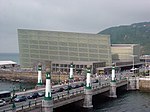St. Ignatius College, San Sebastian
1929 establishments in SpainCatholic schools in SpainEducational institutions established in 1929Jesuit secondary schools in SpainSan Sebastián
St. Ignatius College, San Sebastian ("Donostia" in Basque), on the northwest coast of Spain was founded by the Society of Jesus in 1929 and currently includes pre-primary through the baccalaureate. It is also affiliated with the nurseries of the Servants of Jesus and of the Carmelite Teresiana Missionaries.On 1 October 1929 classes began at San Ignacio de Loyola School in San Sebastián. The first lay director, Amaia Arzamendi, was appointed in 2009.
Excerpt from the Wikipedia article St. Ignatius College, San Sebastian (License: CC BY-SA 3.0, Authors).St. Ignatius College, San Sebastian
Ategorrietako Galtzada Zaharra, San Sebastián Ulia (Ategorrieta - Ulia)
Geographical coordinates (GPS) Address Website Nearby Places Show on map
Geographical coordinates (GPS)
| Latitude | Longitude |
|---|---|
| N 43.323094444444 ° | E -1.9653444444444 ° |
Address
San Ignazio ikastetxea
Ategorrietako Galtzada Zaharra 28
20013 San Sebastián, Ulia (Ategorrieta - Ulia)
Autonomous Community of the Basque Country, Spain
Open on Google Maps











